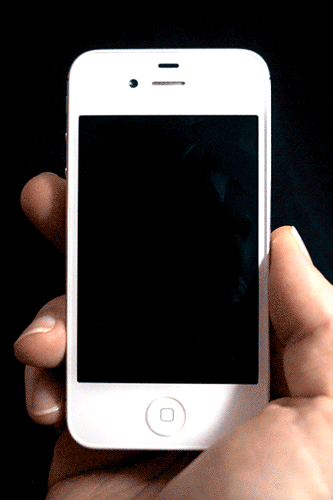1. The Brief and Wondrous Life of the New Aesthetic
In DIS magazine, Nick Scholl asked, "Okay, are we done talking about post-internet, new aesthetic, death of painting, etc.?" Scholl was referring to JK Keller. JK Keller creates patterns of oil on iPhone screens, captures those reflective screens on video, and then transforms the video into .gifs for the internet. (Go look at some.) The .gifs animate light reflected across a jeejah screen after a hundred oily finger-swipes. The finger-swipe medium is grimy, as grimy as all of the dirt missing from Apple's perfectly white and silver surfaces. Indeed, Keller's surfaces subvert easy analogy of [ digital : surface :: physical : depth ] . Keller reminds us that we see the internet through a glass darkly. Dark, stinky and oily, meatspace (in the parlance of the cyberpunks) obfuscates our access to the Realm of (digital) Forms: the internet.
The internet, according to the New Aesthetic, found its way into meatspace; better, it has enjoyed "an eruption of the digital into the physical." "Eruption"--a fantastically Freudian word that exposes the masculinist tendencies of the tech-design crowd--is conspicuously absent in the introduction to the New Aesthetic by James Bridle. Birdle eschews "eruption" in favor of total epistemological tearage. Bridle articulates that tearage by way of Tom Taylor: "It’s 2011, and I have no idea what anything is or does anymore." "Anything is or does" interchangeably, within Taylor's apparently functionalist system. Against modernist functionalism, David Pye wrote in 1964 that,
The concept of function in design, and even the doctrine of functionalism, might be worth a little attention if things ever worked. It is, however, obvious that they do not (The Nature of Design, 10).Tom Taylor may have no idea what anything is or does anymore, but Bruce Sterling does. In a pair of outstanding essays, Sterling takes issue with the very clutteredness of the New Aesthetic, then its disposition to "our virtual buddies." First,
These are the forms of imagery that Bridle’s collaborators have thrown over his transom. There’s lots, they’re all cool, and most are rather interesting, and some are even profound, but they don’t march together.And second,
Those cats just don’t herd yet; that puzzle is still in its pieces. One can try to cluster them, in a vague ecumenical way, by saying, “This is how contemporary reality looks to our pals, the visionary machines.” But that’s not convincing... Let’s critically nitpick a little, shall we? Dazzle camouflage has nothing to do with “machine vision.” Machines are incapable of a state of mind like “dazzle.” Camou is all about human vision.
The real issue now is this intimate participation of machinery in cultural production. Practically everything we do in this era that is novel, and different, and challenging, has some kind of computational flavor.Sterling asks us to think of the internet and the New Aesthetic as computational collaborators in our cognitive discoveries. What, then, is the co-discovery of JK Keller and his jeejah? The easy answer is that there is none: Keller reasserts the supremacy of meatspace by turning his computational co-discoverer back into a shiny surface. The digital seemed to have erupted into the physical, and the physical seems to be re-enveloping the digital. But is this necessarily beyond the boundaries of the New Aesthetics?
Forms of creative practice have arisen that are co-discovery with machines. They’re cognition-computation mashups and hybrids.
I think Sterling, Pye, and Taylor are all confouned by the limits of relational aesthetics. In the next installment, I'll discuss Graham Harman's relevance to the art of greasy surfaces.



No comments:
Post a Comment